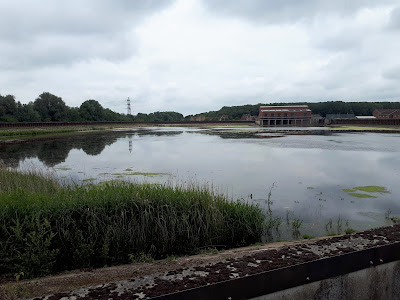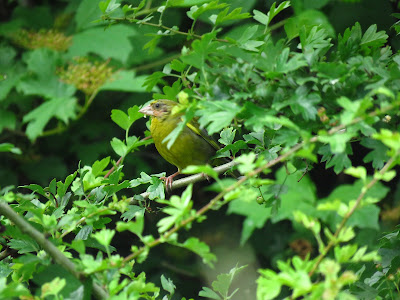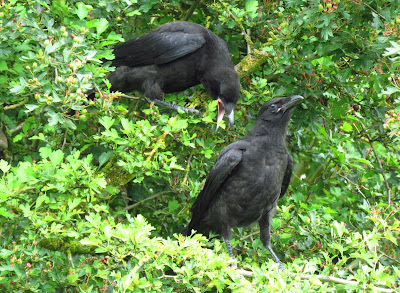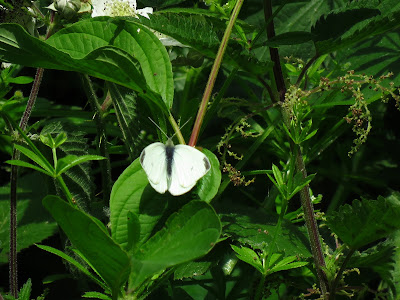 I have a backlog of three weeks at the patch to write up so I decided to do a summary and a bit of an overview of the year so far as I am half way through my weekly visits to this urban 1 km grid square in the heart of Hull.
I have a backlog of three weeks at the patch to write up so I decided to do a summary and a bit of an overview of the year so far as I am half way through my weekly visits to this urban 1 km grid square in the heart of Hull.
Breeding birds
I have recorded 58 species this year in the square in 47 visits. Of those, 27 are resident and 9 are summer migrants. The fledglings of residents, including Feral Pigeon, Great tit, Carrion Crow, Magpie, Blackbird, Robin, Wren, Starling, House Sparrow, Greenfinch, Goldfinch, Moorhen and Mallard have been recorded in the area, most in the last few weeks. Several Song Thrushes (possibly 3 pairs) have been seen carrying food, indicating the presence of young in nests. The presence of a Sparrowhawk nest was noted by the begging call of the female from trees, but due to the foliage, the nest itself could not be located. Even the fledglings of the summer migrants have started to appear in the last couple of weeks, with Blackcap and Whitethroat young seen. In total, fledglings of 15 species have been recorded. Furthermore, Herring Gulls and Lesser Black-backed Gulls are breeding on the roofs of the industrial estate (crown paints must have quite a few nests). Except for a visible Lesser Black-backed Gull nest, no gull nests are visible from ground level. Several Swallows have been seen circling the bridge at Fountain Road.
Blackcap fledgling.
Greenfinch Fledgling.
The Greenfinch parent looking a bit bedragled.
The latest and most numerous batch of ducklings, 8 (one just out of the frame).
A duckling watches for insects on the drain.
Fledgling crows just by the drain, they were quite entertaining to watch.
Flegdling Whithethroat (also top shot).
Other birds
Six of the species are wintering and were regularly recorded (Common Gull, Black-headed Gull, Cormorant, Redshank, Goldcrest, and Little Grebe). The rest of species include fly-overs (Grey Heron, Rook) and occasional visitors from outside the area (e.g. Kestrel, Grey Wagtail, Greylag, Coot) and some come from single records during passage (Teal, Red Kite, Willow Warbler, Sedge Warbler). The status of a few species remains a bit mysterious. For example, House Martins seem plentiful over the drain from the cycle lane to Fountain Road, but I haven't located the colony, although it must be nearby. Lesser Whitethroat has just 3 records in the same area, but spread in time, so a pair could be breeding. A passing cargo train disturbed a couple of Grey Wagtails, which were seen flying off from the river. This was to the north of the km2 in an area out of difficult access by the river Hull, so it is possible that a pair is breeding in the area.
Pied Wagtail.
Herring and Lesser black-backed gulls gather to bath on the river at low tide.
Feral Pigeon under Wilmington Bridge.
Butterflies
The butterfly season, which started in late march, pretty much halted for a couple of months with the cold April and wet May. In June there have been plenty of warm, sunny days and I've been able to add several new species to the year list. So far 12 species have been recorded including: Comma, Small Tortoiseshell, Painted Lady, Speckled Wood, Peacock, Large White, Small White, Green-veined white, Brimstone, Large Skipper, Common Blue and Orange Tip. Hopefully a few more species will be added for July. Caterpillars of Small Tortoiseshell and Peacock were plentiful in nettles along the drain and a Red Admiral was observed ovipositing. The Sculcoates N cemetery has an excellent meadow where Large Skipper and Common Blue have been seen, and also the day-flying five-spot burnet moth.
Common Blue.
A very fresh Small Tortoiseshell.
Small White.
The first Red Admiral of the year.
Red Admiral.
Common Blue.
Ovipositing Red Admiral.
Other insects
The verges by the drain and the meadow area of the north cemetery at Sculcoates are a haven for insects.
Volucella bombylans
5 spot burnet, Sculcoates cemetery.
Speckled Wood.
The only (to my knowledge) resident horse in the patch came to check me out.
























































